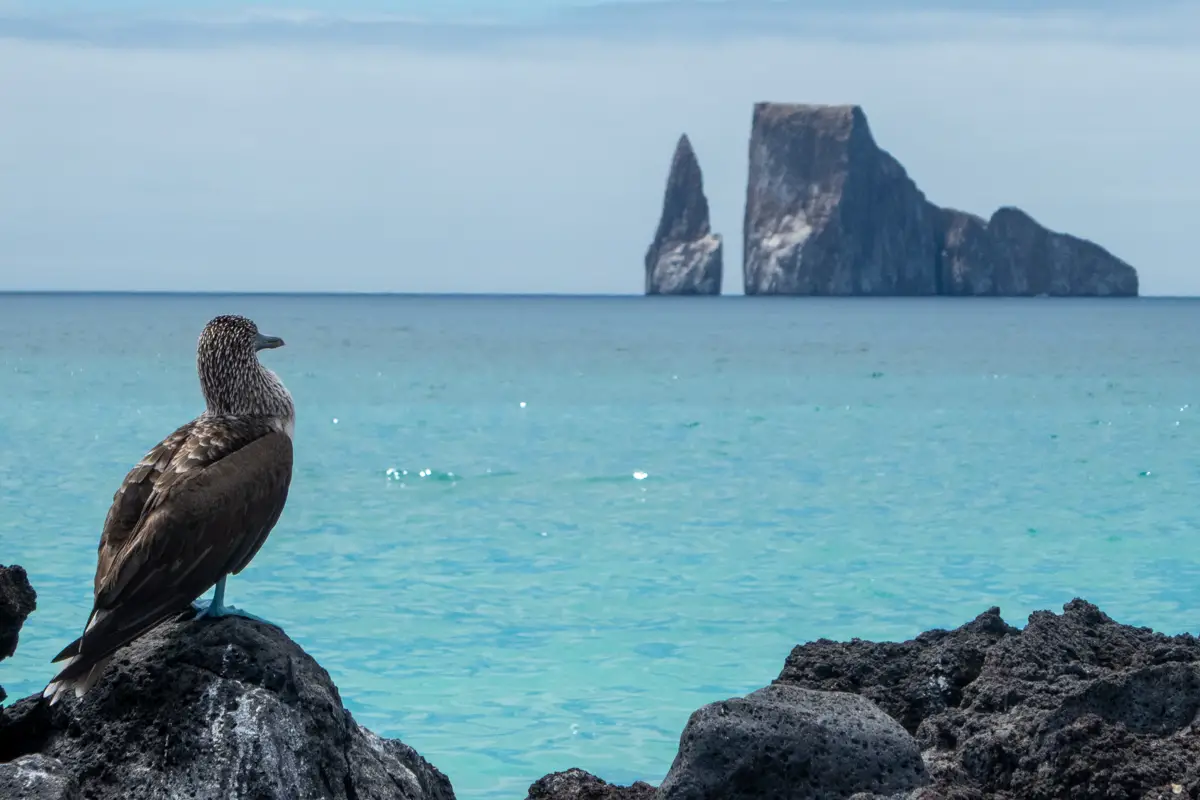If you’re hoping to spot wildlife on the Galapagos Islands (and let’s face it, who isn’t?), you’re in the right place. The animals that live on the Galapagos Islands are some of the most exotic, interesting and unique that you can find anywhere in the world.
What many people might not know until they visit, is that the Galapagos Islands are not just the handful of main islands that you may have heard of. In fact, this archipelago is made up of 18 main islands, 3 smaller ones and 107 islets and rocks!
This means spotting that the animals of the Galapagos are spread far and wide over a large area and what you can see on one island, you may not see on another. To help you get the most out of your bucket list trip, I’ll reveal exactly where to see the most famous Galapagos animals.
Read more: (opens in new tab)
- Sierra Negra Volcano Hike on Isla Isabela
- What to Know Before Planning a trip to Galapagos
- 3 of the Best Ecuador Itineraries
23 Unique Animals on the Galapagos Islands
I’ve listed some of the most magical and unique wildlife that you can find on the Galapagos Islands below. This is by no means an exhaustive list (there are over 7,000 species on the archipelago) but includes some of the most famous Galapagos animals.
1. Blue-Footed Booby
- Where: Isabela, Pinzon, Floreana, Santa Cruz, Española, Fernandina, San Cristobal
- Conservation status: Least concern

The blue-footed booby is one of the Galapagos’ most iconic animals. These marine birds are best known for their bright blue feet which they use to attract members of the opposite sex. According to National Geographic, the bluer the feet, the more attractive they will appear as a mate.
Don’t make the mistake of thinking that these birds are endemic to the island though. They can be found in many subtropical and tropical areas of the Pacific Ocean such as Islas Ballestas in Peru and Isla de la Plata in Ecuador.
Fun Fact: When trying to woo a mate, the blue-footed booby will perform a comical mating dance that involves showing off their fabulous feet.
2. Scalloped Hammerhead Shark
- Where: Kicker Rock (San Cristobal), Wolf, Darwin, Gordon Rocks (Santa Cruz), Española
- Conservation status: Critically endangered
Ever been snorkelling or diving with hammerhead sharks? If the answer to this question is no, then you’ll be delighted to hear that the Galapagos Islands are one place where you can do this!
Hammerhead sharks live in tropical coastal waters and thankfully for all those divers, are not generally dangerous to humans. Unfortunately, much like many other animals on this list, the Scalloped Hammerhead Shark is critically endangered.
This is a result of overfishing and the demand for shark based products in the East, such as shark fin soup. Illegal fishing in Galapagos waters is also a persistent problem.
Fun Fact: These hammerheads have their eyes and gills on either side of their wide heads.
3. Sally Lightfoot Crabs
- Where: All over the Galapagos beach shoreline
- Conservation status: Least concern

The sally lightfoot crab is a regular feature on the lava rocks of the Galapagos Islands. Interestingly, these crabs change colour as they age, going from black when they are babies to bright orange when they are matured.
Sally lightfoot crabs fit perfectly into the ecosystem, eating the parasites and dead skin from the marine iguanas. They are very quick and even have the ability to climb upside down. This is quite an unnerving trait when they are on the underside of the bridge you are standing on!
Fun Fact: These crabs change colour over the years by shedding their shells.
4. Waved Albatross
- Where: Española
- Conservation status: Critically endangered
Although the albatross is one of the largest flying birds in the world, this particular kind is classed as medium-sized. The waved albatross gets its name from the wave like patterns on its feathers and is easily recognisable for its cream coloured head and neck.
Unlike much of the other wildlife on this list, the albatross is not very easy to spot on the Galapagos Islands. In fact, you’ll only really stand a chance if you visit the island of Española.
Unfortunately, these birds are now critically endangered, largely because of the increased threat of longline fishing. If you miss them on the island of Española, they also hang out on Isla de la Plata, just off of Puerto Lopez in mainland Ecuador.
Fun Fact: From January to March every year, the waved albatross are in flight as they are not breeding or incubating eggs.
5. Galapagos Giant Tortoise
- Where: Española, Pinzon, Santa Cruz, Isabela, San Cristobal, Santiago
- Conservation status: Vulnerable

Introducing the poster child for the Galapagos, the giant tortoise! These islands are so synonymous with these ancient reptiles that the name Galapagos actually derives from an old Spanish word for tortoise (Galapágo).
They are the largest of all the tortoise species and also the oldest. On average, a Galapagos giant tortoise will live for over a hundred years but the oldest ever recorded was an impressive 176 years old!
Unfortunately, owing to the introduction of non-native species, none of the tortoises born in the wild currently survive. There is hope that by controlling invasive species, eventually, Giant Land Tortoises will once more be able to survive from birth in their natural environment instead of breeding centres.
Fun Fact: A Galapagos giant tortoise can go an entire year without eating!
6. Galapagos Lava Lizard
- Where: Santa Cruz, Santa Fe, Santiago
- Conservation status: Least concern

Endemic to the Galapagos Islands, the Galapagos lava lizard is one of the easiest reptiles to spot as they live on most of the islands. They can be seen basking in the sun on the old lava flows or hanging out with marine iguanas.
They are small, ranging from 4-7 inches long, with long tails and pointy heads. The males can be very territorial and will ward off outsiders by doing macho push up motions. Turns out this kind of bravado extends way past the doors of Pure Gym!
Fun Fact: If lava lizards are attacked, they can drop their tail. A new one will grow in its place but it rarely reaches the same length as the original.
7. Frigatebird
- Where: Floreana, San Cristobal, North Seymour and Genovesa Island
- Conservation status: Least concern

The frigatebird is surely one of the most beautiful birds in the Galapagos. They have a long hooked beak and are usually black. The males can be identified for their shocking red crest which they inflate during mating season to attract a female.
These birds are incredible fliers and can coast for weeks using the wind currents. Their diet mainly consists of seafood such as squid and fish, however, these cheeky birds will also steal food from other seabirds.
Frigatebirds are seasonally monogamous, meaning they will choose one partner exclusively but only for a season. These savvy little birds know how to get the best of both worlds!
Fun Fact: Frigatebirds don’t have waterproof feathers so they can’t land in the ocean, this means that they need to dive for their food.
8. Manta Ray
- Where: Waters around Darwin and Wolf Islands
- Conservation status: Vulnerable
Divers will know that the Galapagos Islands are a haven for underwater wildlife. Perhaps one of the most enchanting types of fish that you can see anywhere, the manta rays on the Galapagos tend to gather in the waters around Darwin and Wolf.
Even if you’re not qualified to dive, you may still get lucky and see manta rays from the ocean’s surface. They often swim in shallow water and are easily mistaken for sharks, as their dorsal fin sticks out above the water.
Fun Fact: Out of all the living fish, manta rays have the largest body weight to brain ratio, making them immensely clever!
9. American Flamingo
- Where: Puerto Villamil (Isabela), Punta Cormorant lagoon (Floreana), Bahis Tortuga and Las Bachas (Santa Cruz) and Puerto Egas (Santiago)
- Conservation status: Least concern

These birds are found all over the Americas, from the Galapagos to Colombia and even right up to Florida! Although the population that are found in the Galapagos is still technically American flamingos, they are genetically different from the kind found in the Caribbean. When compared, the ones on the Galapagos are the smaller of the two and also lay the smallest eggs.
When flamingos hatch, they’re a dull grey colour instead of the stunning pink we usually think of. Over their lifetime, the food they consume affects their overall colouration. Flamingos in the Galapagos consume a huge amount of crustaceans and get their lively colouration from the carotenoids contained within.
Fun Fact: Flamingos eat with their heads upside down in the water. Inside their beaks, there are plates called lamellae which act as filters to trap the shrimp and sieve out the mud.
10. Flightless Cormorant
- Where: The east coast Fernandina and the north-west coast ofIsabela
- Conservation status: Vulnerable
Although there are 29 different species of cormorants, the Galagapos cormorant is the only one that cannot fly. Their wings are just a third of the size they would need to be if they were going to take to the air.
These birds survive on octopus and squid which can only be found on the seabed. This makes them excellent divers. However, because they cannot fly, they have no choice but to live on the coastal parts of Fernandina and Isabela.
Much like blue-footed boobys, these birds perform a fascinating mating dance to woo a female. Once the deal has been struck, the pair get to work making a nest from seaweed where the female will eventually lay her eggs.
Fun Fact: There are an estimated 1000 breeding pairs of flightless cormorant in the Galapagos Islands.
11. Galapagos Sea Lion
- Where: All over the islands
- Conservation status: Endangered

Sea lions are the largest of all the endemic animals of the Galapagos Islands. They are some of the easiest Galapagos wildlife to see as they congregate in huge numbers along the beaches and shorelines. You can even see them at the Puerto Ayora fish market where they try to steal food!
These animals are very sociable and naturally inquisitive which makes them very vulnerable to humans. If you are swimming in the sea, it is not unusual for a sea lion to join you. While this wild experience can be magical, it does also mean that they are far more likely to approach a fishing net and suffer an injury.
Despite their apparent lack of grace on land, they are extremely talented swimmers and like to show off their corkscrew turns at any available opportunity!
Fun Fact: Males and females can be distinguished from their size and forehead shape.
12. Land Iguana
- Where: Santa Cruz, Isabela, North Seymour, South Plaza and Fernandina
- Conservation status: Vulnerable

Rather than explain what the land iguana looks like, I’ll leave it to Charles Darwin. Writing in the Voyage of the Beagle, he said; “They are ugly animals, of a yellowish orange beneath, and of a brownish-red colour above: from their low facial angle they have a singularly stupid appearance.” What a charming man.
Although it is claimed that there was once an abundance of land iguanas on the Galapagos, they are now much fewer in number, with just 5,000 to 10,000 of them left. It is believed that they have been largely wiped out by the introduction of animals such as cats, pigs and rats.
Fun Fact: It is estimated that the Galapagos land iguanas can live up to 60 years old.
13. Galapagos Fur Seal
- Where: All over the islands but mainly on Isabela and Fernandina
- Conservation status: Endangered
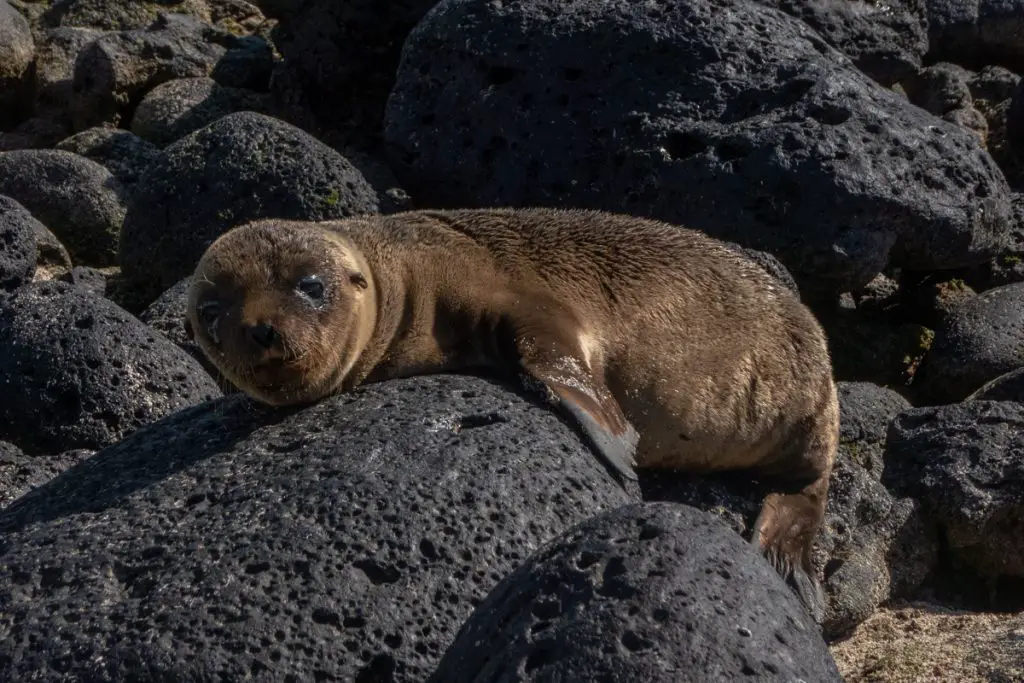
Many visitors to the Galapagos tend to confuse the fur seal with the sea lion, both of which are endemic to the archipelago. The fur seals are generally much smaller than the sea lions and their ears also tend to stick out more.
When dry, the fur seals tend to have lighter pelts, appearing dull brown or yellow. Sadly, these seals are endangered, largely because of past practices when they were hunted for their fur. The natural predators of the fur seal are orcas and sharks, however, El Niño is now beginning to have a huge impact on the species as lessening food resources can force mothers to abandon their pups.
Fun Fact: The Galapagos fur seal spends around 70% of its time on land!
14. Darwin Finch
- Where: All over the islands
- Conservation status: Vulnerable

Named after Charles Darwin and in reference to his theory of evolution, these tiny little birds are one of Galapagos’ most famous. They vary in size from around 10-20 cm, making it very easy for them to pinch pieces of food from your plate when you are eating al fresco!
All of Darwin’s finches have evolved to have different beaks. This helps them to occupy different corners of the food chain, with each beak being suited to the bird’s individual diet. Although some species of finch can only be found on certain islands, you are pretty much guaranteed to see at least some of them no matter where in the archipelago you travel to.
Fun Fact: On Wolf, there are vampire finches that peck away at the skin of other birds to feed on their blood.
15. Galapagos Penguin
- Where: Isabela, Santiago, Floreana, Fernandina and Bartolome
- Conservation status: Endangered
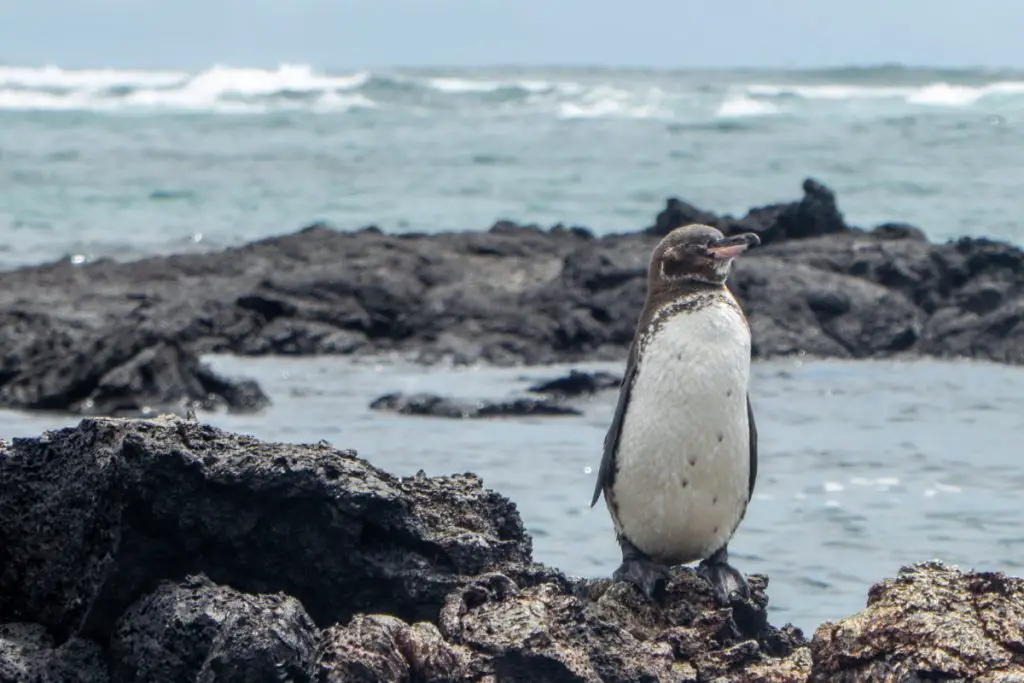
The Galapagos penguin is perhaps one of the most important species on the whole of the islands. It is the only type of penguin found north of the equator and one of the rarest in the world. It is particularly small, standing at just 49-50 cm tall.
The El Niño phenomenon has long threatened their populations, and as the availability of fish has decreased, many birds have starved. With as few as just 800 breeding pairs, the Galapagos penguin is considered to be endangered and therefore the conservation teams around the islands are trying hard to protect them.
Fun Fact: The Galapagos penguin moults twice a year.
16. Whale Shark
- Where: Waters around Darwin and Wolf
- Conservation status: Endangered
The whale shark is the largest fish in the world and can be seen in Galapagos waters from June to December. They are filter feeders which pose no danger to humans, although the largest ever confirmed measures in at an intimidating 18.8 metres!
There is much about this fascinating fish that researchers are yet to still discover, including where they give birth. Pregnant females are routinely spotted in the waters of the Galapagos but presently, no one has ever seen a whale shark give birth. We do know, however, that instead of laying eggs, whale sharks give birth to live young.
Fun Fact: Whale sharks have around 3,000 teeth in their mouths, even though they don’t chew!
17. Marine Iguana
- Where: Santa Cruz, San Cristobal, Española, Floreana, Isabela and Fernandina
- Conservation status: Vulnerable
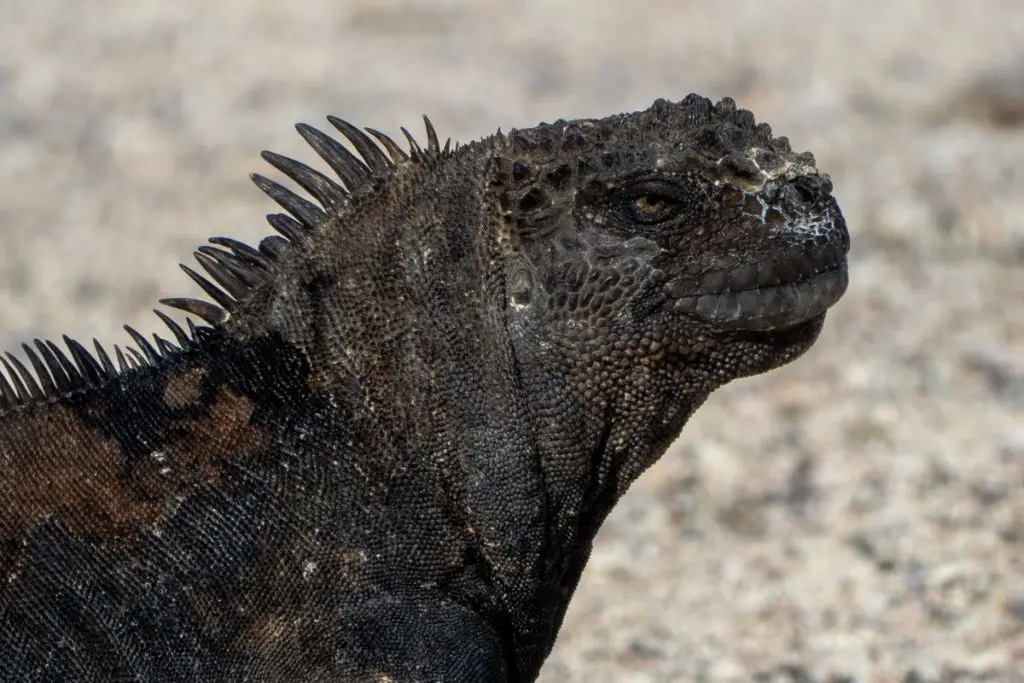
Also known as the sea iguana, this endemic reptile is another example of unique Galapagos wildlife. As you’d assume from the name, these iguanas are incredible swimmers and are breathtakingly agile in the water.
These sooty black reptiles can be seen strolling about all over the islands, often in coastal areas. They congregate together and bask in the sun on the lava rocks.
Marine iguanas forage pretty much exclusively on red and green algae but sometimes eat insects and crustaceans too. It is thought that the marine iguana evolved some 4.5 million years ago from land iguanas.
Fun Fact: To rid their bodies of excess salt from the sea, marine iguanas sneeze out the salt through one of their nasal glands.
18. Whitetip Reef Sharks
- Where: Northern Isabela and North Seymour
- Conservation status: Near Threatened

The whitetip reef shark is the most common type of shark living in the Galapagos. They tend to be found around rocky reefs and in caves, such as Los Tuneles in Isla Isabela. As the name would suggest, they are characterised by the white tips of their fins.
These sharks prefer shallow water and are easy to find on account of them returning to the same caves again and again. They live communally so it is common to see many sharks crowding together in the caves. Although they are one of the smaller shark species, they can grow up to 1.6 metres long which is still daunting when you’re swimming with them!
Fun Fact: You can often see whitetip reef sharks lying motionless along the seafloor. This is because they don’t need to move to breathe.
19. Nazca Booby
- Where: Española, San Cristobal and Genovesa
- Conservation status: Least Concern
Although often overshadowed by the flashy colours of the blue-footed booby, the Nazca booby is another bird that wildlife enthusiasts will not want to miss. This seabird can be identified by its predominantly white body with black and white wings. It has a bright orange beak, along with a dark face.
They nest on bare cliffs but typically produce a low yield of eggs. If a booby is lucky enough to lay two eggs, it is quite normal for only one to survive. Although overfishing has led to a slight decline in the numbers of Nazca boobys, there has been nothing substantial enough to bring about a change in their consideration status.
Fun Fact: If it gets the opportunity, the vampire finch will feed on the Nazca booby.
20. Galapagos Green Turtle
- Where: Found in the waters of the archipelago
- Conservation status: Endangered
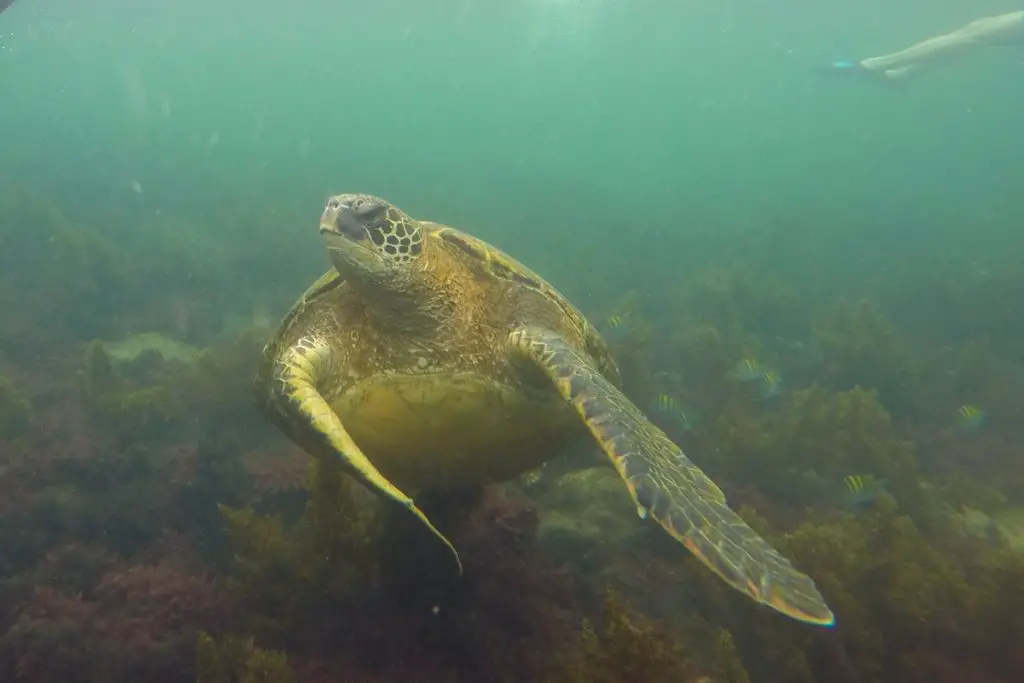
The Galapagos green turtle is an animal that many visitors to the Galapagos can’t wait to see. They swim in the tropical waters of the archipelago and live for an average of 80 years. They are the only species of sea turtle found in the Galapagos and you are likely to catch a glimpse of them if you are diving or snorkelling.
Adult sea turtles have long been targeted by fisheries as they were previously widely eaten. Although this has become less common, bycatch is an ever-growing problem. Unfortunately, once a turtle gets trapped in a net, it can struggle to release itself and is often already dead by the time it is landed.
Fun Fact: The Galapagos sea turtle has glands under its eyes that allow it to clear excess salts.
21. Pacific Seahorse
- Where: Los Tuneles in Isabela Island
- Conservation status: Vulnerable
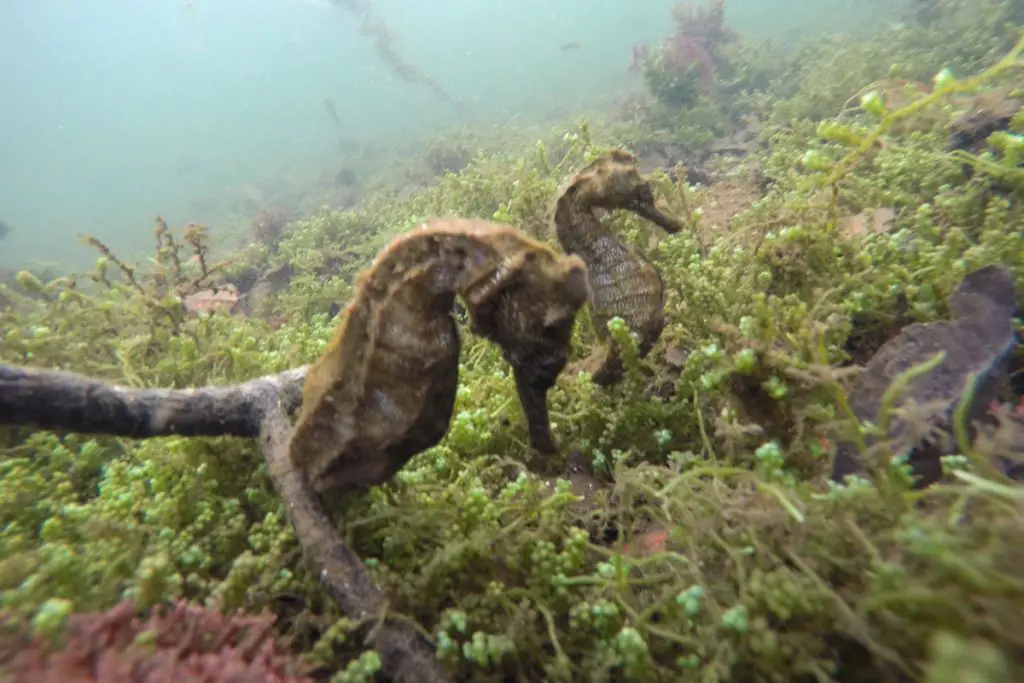
The Pacific seahorse is found in the Los Tuneles area of Isabela Island. You may also know it as the giant seahorse. Even though it is not the largest seahorse out there, it averages 12 to 19 centimetres in length.
When you are snorkelling or diving to see seahorses, be very careful not to let your flippers scrape along the seabed. This does untold damage to the seahorse’s habitat and, along with their use in traditional Chinese medicine, is contributing to their huge decline in numbers.
Fun Fact: A baby Pacific seahorse is called a fry.
22. Red-Footed Booby
- Where: San Cristobal and Genovesa
- Conservation status: Least concern
Similar in appearance to the blue-footed booby, the red-footed booby has bright red feet and a pale blue beak. It is the third type of booby which is found in the Galapagos and the smallest of them all. These boobys get their name from the Spanish word ‘bobo’. This roughly translates to clown or fool and references the clumsy way they move.
They are sociable birds and hunt in large groups, diving for their prey in the sea. When they are not hunting, they tend to be breeding. Like Nazca boobys, they also nest on land, mainly in shrubbery.
Fun Fact: Red-footed boobys reach sexual maturity at around 3 years of age.
23. Galapagos Hawk
- Where: Fernandina and Isabela
- Conservation status: Vulnerable
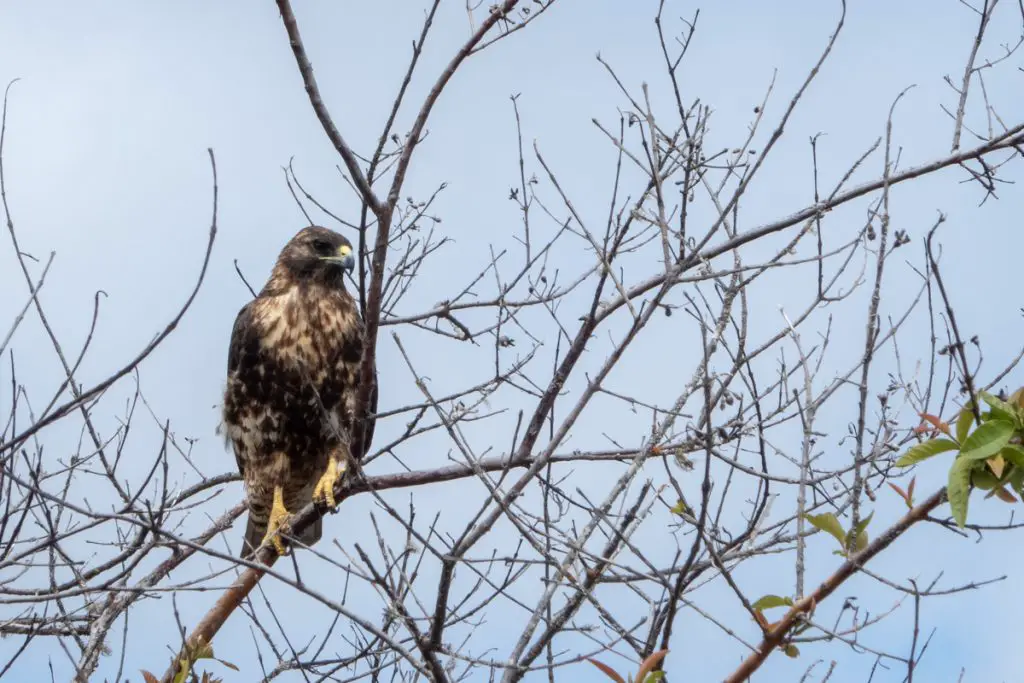
The Galapagos Hawk is a rare sight on many of the islands. Extinct from Baltra, Daphne, Floreana, San Cristobal and Seymour, these birds have suffered greatly from the introduction of invasive species. Due to competition for food and changes to their habitat, there are now as few as 150 mating pairs in existence.
After cats were introduced to the islands, a huge drop in the numbers of Galapagos hawks was recorded. This was due to the increased competition for food.
This bird is fascinating for its unique breeding system. Cooperative polyandry means that the male hawks are monogamous, however, throughout the nesting period, the females can mate with up to seven males. The chicks are then raised by a combination of all parties.
Fun Fact: The wingspan of the Galapagos hawk is around 1.2 metres wide.
What is your favourite animal from the Galapagos? Let me know in the comments!

